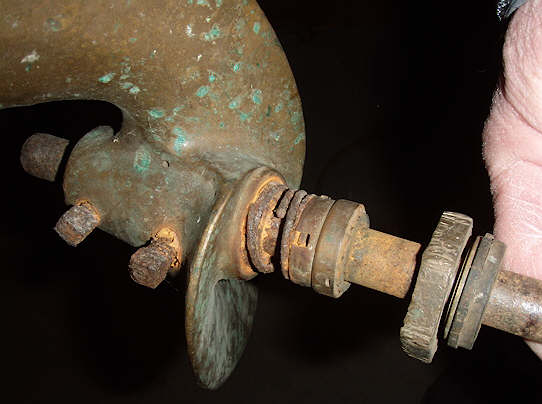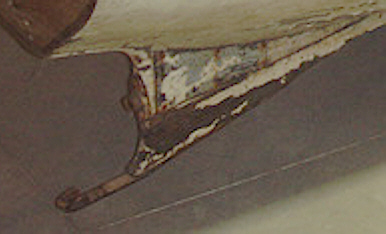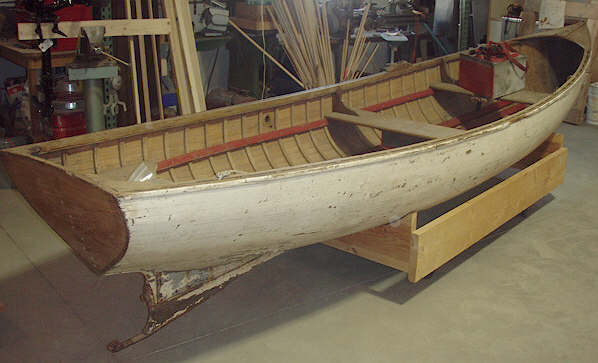| Author |
Message |
    
thomas
Senior Member
Username: thomas
Post Number: 327
Registered: 07-2002

| | Posted on Saturday, January 31, 2009 - 09:32 am: | 




|
Pictures from Dick Alcock. He is restoring this inboard boat and was wondering if anyone has ever seen a "face seal" type shaft log seal. It has a spring and a flat disk that is pressed into the shaft log end (but parts are missing so...)
Any help is appreciated. |
    
thomas
Senior Member
Username: thomas
Post Number: 328
Registered: 07-2002

| | Posted on Saturday, January 31, 2009 - 09:37 am: | 




|
This shows the face seal parts that are on the shaft. |
    
thomas
Senior Member
Username: thomas
Post Number: 329
Registered: 07-2002

| | Posted on Saturday, January 31, 2009 - 09:39 am: | 




|
closeup up the shaft log end |
    
thomas
Senior Member
Username: thomas
Post Number: 330
Registered: 07-2002

| | Posted on Saturday, January 31, 2009 - 09:40 am: | 




|
The boat being restored.  |
    
john_archibald
Senior Member
Username: john_archibald
Post Number: 101
Registered: 08-2006

| | Posted on Saturday, January 31, 2009 - 10:46 am: | 




|
Thomas,
I have not seen a seal like this before used on small launches myself. However, I suspect that the missing part may have been a piece ( a ring ) of lignum vitae. The spring loaded brass face would press up against this piece of wood and the lignum vitae, being very resinous, would lubricate itself aided by a small bit of water that would always be present. A seal like this would last a lifetime.
Dick could always replace the seal with an ordinary stuffing box seal and no one would know the difference. If he is a purist, he won't do things that way.
The key to the lignum vitae seal is that the faying surfaces must be true and smooth, a high polish would be good to have on both.
That is a beautiful carvel hull. Where and when was it made, etc? It looks about 15 or 16 feet long.
Archibald
Northfield, Minnesota |
    
jb_castagnos
Senior Member
Username: jb_castagnos
Post Number: 430
Registered: 07-2002

| | Posted on Saturday, January 31, 2009 - 06:25 pm: | 




|
It looks like someone may have adapted a water pump seal, if sealed from underneath I wonder how they lubed the bearings. Most were water lubed-cooled. |
    
thomas
Senior Member
Username: thomas
Post Number: 331
Registered: 07-2002

| | Posted on Sunday, February 01, 2009 - 01:08 pm: | 




|
I have passed on to Dick all the suggestions
about the seal so far. I have to admit that a jury-rigged seal would be tough to figure out if some of the parts were missing. |
    
keith
Senior Member
Username: keith
Post Number: 229
Registered: 02-2002

| | Posted on Sunday, February 01, 2009 - 08:23 pm: | 




|
Thomas,
A better closeup view of the shaftlog or exit area would help. Are the parts to the left of the first picture threaded together? |
    
raa
New member
Username: raa
Post Number: 1
Registered: 02-2007
| | Posted on Sunday, February 01, 2009 - 09:59 pm: | 




|
Keith they are all loose parts with one missing It sure could be a water pump seal but things seem to fit with shaft log parts and the 5/8" shaft fits the part just to the right of the spring and it has a old rubber seal to fit the shaft snuggly. |
    
jb_castagnos
Senior Member
Username: jb_castagnos
Post Number: 431
Registered: 07-2002

| | Posted on Monday, February 02, 2009 - 06:27 am: | 




|
5/8" is a common size for well pumps. I think if it were made for a boat the spring would have been brass or stainless. On a water pump this spring is on the dry side. The rotating cup contains a washer to seal it to the shaft and a carbon face, the spring pushes this against a ceramic or stainless face that's stationary. Go to a hardware store or pump supply and check them out, I have one here for my well. I would like to know what type bearing they used on the lower end of the shaft, a cutless bearing won't last long if run dry and it won't last in oil. If it was bronze or babbit it would have to be greased or oiled. |
    
raa
New member
Username: raa
Post Number: 2
Registered: 02-2007
| | Posted on Monday, February 02, 2009 - 07:06 pm: | 




|
Many thanks for all the comments and help.
I think that it is a water pump face seal which was adapted to the original shaft seal I guess I was in denial for a few days but I think Jb is the one who is thinking correct. Anyhow thanks for the help.
Dick |


